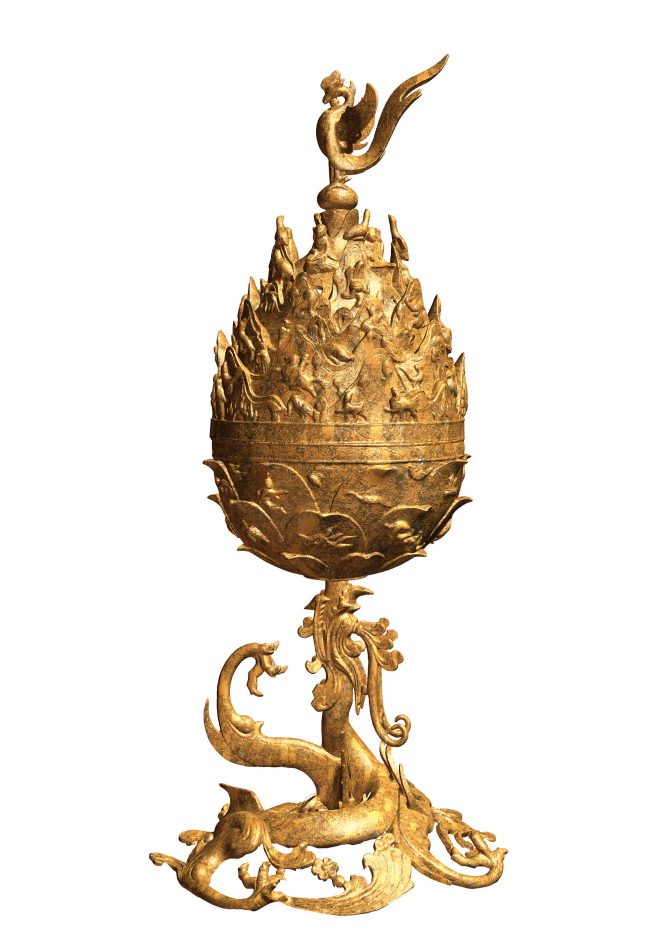
▲ The Baekje Incense Burner
The Baekje Incense Burner was found in the south part of a temple site near the outer fortress of Baekje and tombs in Neungsan-ri in 1993 along with about 450 other artifacts. The burner measures 61.8 cm in height and 11.8 kg in weight.
When it was discovered, the burner was buried in mud and fragments of roof tiles and pottery were scattered around. Textile pieces were also found in the area. Experts assume that they are remnants of a fabric cover of the burner. It is estimated that the burner has maintained its original shape for such a long time because it was vacuum-preserved in mud.
The incense burner can be classified in four parts : the body, lid, phoenix-shaped knob, and support plate. The lid is encircled by 23 mountains cast in five layers. The lid also contains five musicians with different instruments, such as a pipe, small mandolin, string and drum, sixteen other figures, including warriors and horseback riding hunters, and 39 real or imaginary animals, including a phoenix, dragon, tiger, and deer.
Other than these are there various types of dynamic scenery including six types of trees, 12 rocks, trails, streams, waterfalls and lakes.
It had been widely believed the Baekje incense burner might have been copied from the Baksan burners of China, but historians found that it differed from ancient Chinese incense burners in that the expression of mountains was more independent and three-dimensional. With excellent structure and creative design, the incense burner demonstrates the religion and philosophy of Baekje, in which Buddhism and Taoism are mixed together. It is a precious piece of work that provides extensive evidence in understanding not just craftsmanship and arts but also religion and philosophy of the age.
The original incense burner is displayed in the Buyeo National Museum, and the one displayed in the National Museum of Korea is a copy.
This year marks the 20th anniversary of the excavation of the Baekje Incense Burner, which is often dubbed as the essence of Baekje culture. As a treasured cultural heritage with great historic value, the incense burner attracted public attention once again.
In connection with the 59th Baekje Cultural Festival, an international symposium took place on October 1, 2013 under the theme of ※The Baekje Incense Burner, Scent of Ancient Culture§
In the symposium hosted by the Baekje Cultural Heritages Promotion Committee and supervised by the Chungnam Institute of History and Culture and the Buyeo National Museum, domestic and foreign scholars had fierce discussions on six related subjects.
Shin Gwang-seob, the former head of the Buyeo National Museum, delivered a key note speech about the significance of the excavation of the Baekje Incense Burner. He recalled the touching moment when he discovered the incense burner as a leader of the excavation team in 1993, and also introduced a fine piece of writing engraved in the stone storage of cremated remains made during King Chang of Baekje and the measure he used for the temple site and the characteristics and functions of Neungsa Temple.
Lee Do-hak, a professor at Korea National University of Cultural Heritage, said in his presentation titled ※Ancestral Rituals and the Baekje Incense Burner,§ that ※rituals of Baekje include a ritual for the nation*s top ancestral gods, a ritual for heaven and earth, which reflects the characteristics of the northern region, and a ritual for mountains and streams, the nation*s foundation.§ ※
The Baekje Incense Burner is related to the intention of Baekje*s founding fathers from Buyeo who wanted to establish the kingdom*s identity and is a product containing elements of both Buddhism and Taoism.§
Park Gyeong-eun, a curator of the Buyeo National Museum, said in the presentation titled ※Iconographic Research on the Baekje Incense Burner§ that ※the mountainous landscape in the lid reflects the paradise often expressed in tomb mural paintings in East Asia from the sixth to seventh century, the blossoming lotus in the body symbolizes regeneration and eternal life, the dragon represents divinity of mountains,§ and emphasized that the incense burner ※demonstrates the maturity of religion, arts and culture in the late Baekje Dynasty when a strong foundation for sovereignty and absolute royal authority was required.§
Tsutomu Suzuki, the head of Japan*s research institute for crafts, said in his presentation ※Metal Craft of Baekje and Ancient Japan§ that ※the line engraving technique used in the Baekje Incense Burner is a type of carving technique that was found in Baekje artifacts for the first time. This means that the carving technique of China was transferred to Baekje then.§ He also added that ※the carving technique used in the horse*s harness found in the Fujinoki tomb originates in the incense burner of Baekje.§
Soh Hyeon-suk, a professor of the Department of Korean History Education at Wonkwang University, said in her presentation, ※In ancient China, incense burners were used on various occasions such as for daily use, religious rituals, ceremonial events and tomb furnishing,§ and argued that ※The Baekje Incense Burner might have been used for religious purposes because it was excavated in an ancient temple site, but it is more likely to have been used for memorial services because a site of ancestral rite for King Seong of Baekje was also discovered nearby.§
